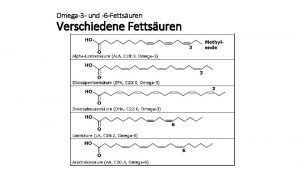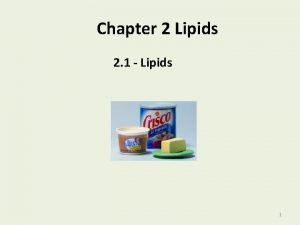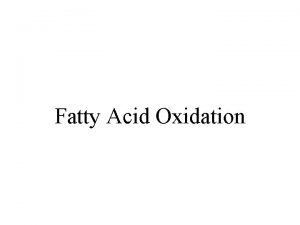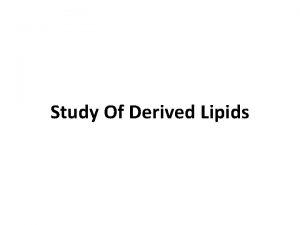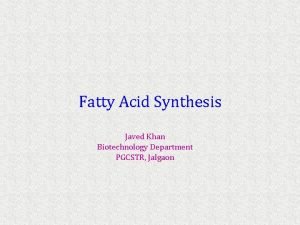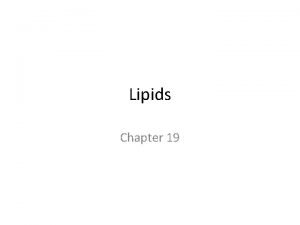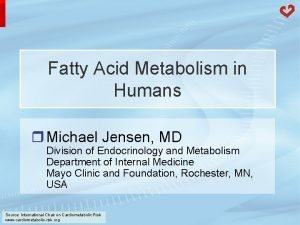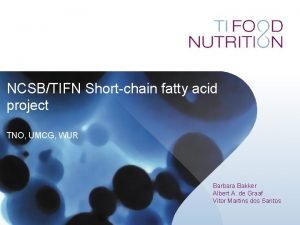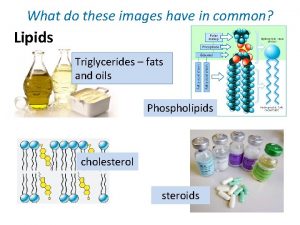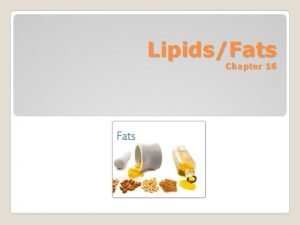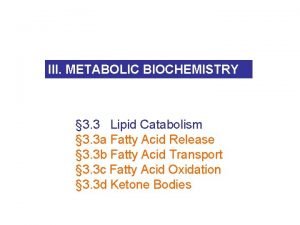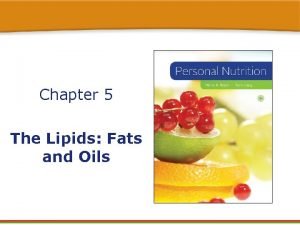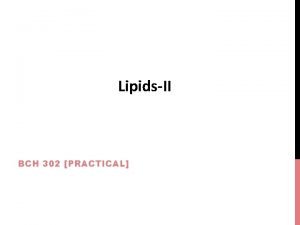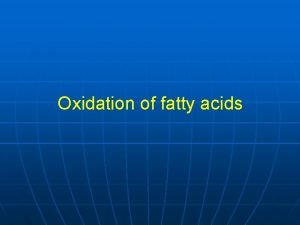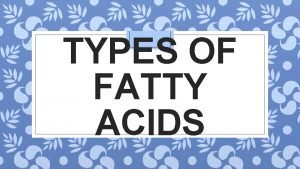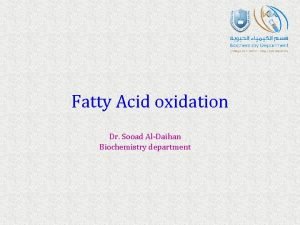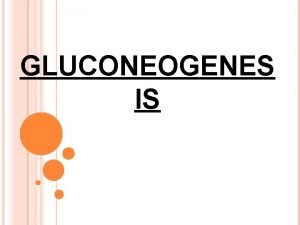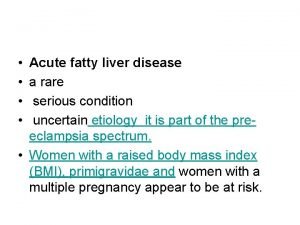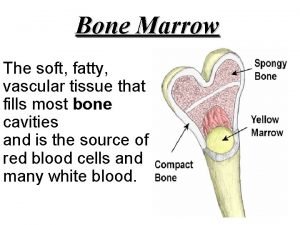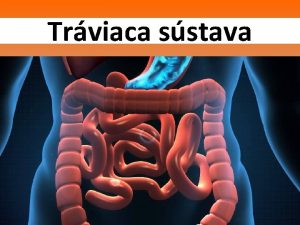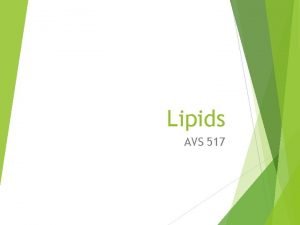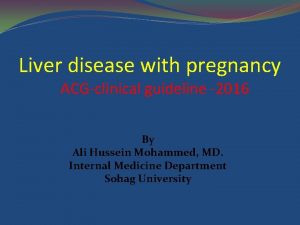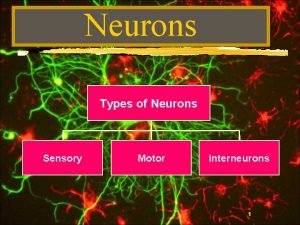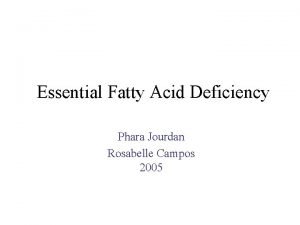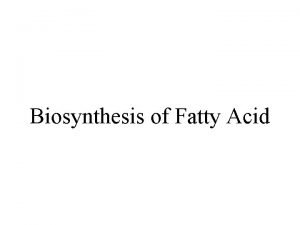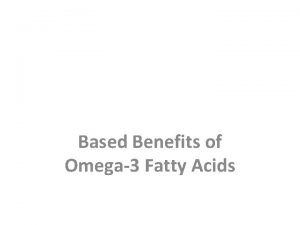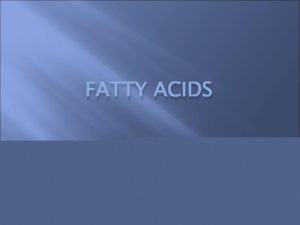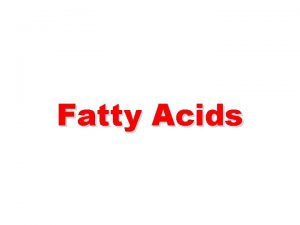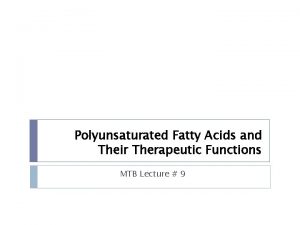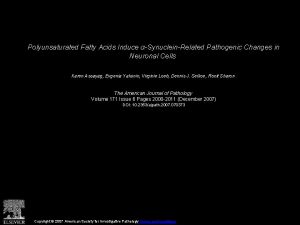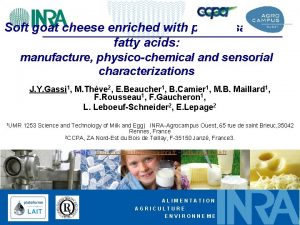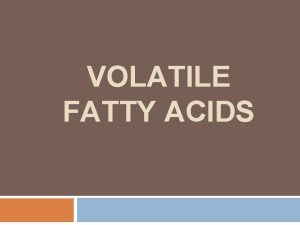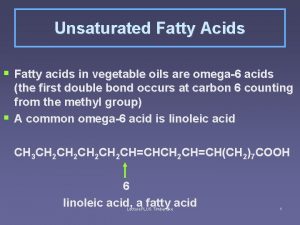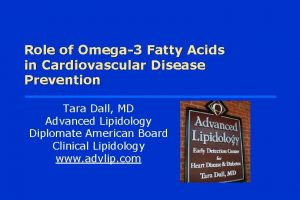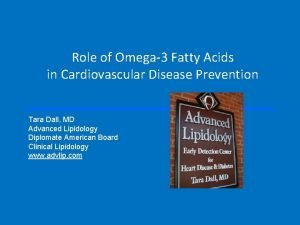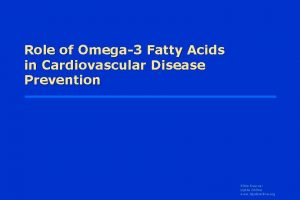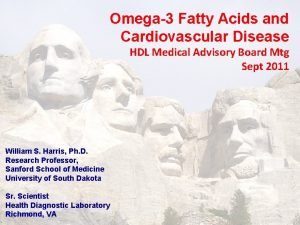Information Omega3 Fatty Acids Omega3 FAs are polyunsaturated




































- Slides: 36


Information: Omega-3 Fatty Acids • Omega-3 FA’s are polyunsaturated, meaning they contain more than one double bond • They are called omega-3 because the first double bond counting from the methyl end of the fatty acid is located at the third carbon atom PBRC 2005

Omega-3 Fatty Acids Types Alpha-linolenic acid (ALA) Eicosapentaenoic acid (EPA) Docosahexaenoic acid (DHA) PBRC 2005

Alpha-linolenic acid (ALA) • Scientific abbreviation is 18: 3 n-3 • The first part (18: 3) suggests that ALA is an 18 carbon fatty acid with 3 double bonds • The second part (n-3) tells you that ALA is an omega-3 fatty acid • It is required for health, but cannot be synthesized in humans • Must be obtained from. PBRC the 2005 diet

Alpha-linolenic Acid • Humans can synthesize other omega-3 fatty acids from ALA: • Eicosapentaenoic acid (EPA): 20: 5 n-3 • Docosahexaenoic acid (DHA): 22: 6 n-3 • These two are usually referred to as marine-derived omega-3 fatty acids because they are abundant in certain species of fish • Whereas, ALA is considered a plant-derived omega 3 fatty acid PBRC 2005

Structures of the Omega-3 Fatty Acids PBRC 2005

Alpha-linolenic acid: Sources Food Serving Alpha-linolenic acid (g) Flaxseed oil Walnuts, English Flaxseeds Walnut Oil Canola Oil Mustard Oil Soybean Oil Walnuts, Black Olive Oil 1 tablespoon 8. 5 1 ounce 2. 6 1 tablespoon 2. 2 1 tablespoon 1. 4 1 tablespoon 1. 2 1 tablespoon 0. 8 1 tablespoon 0. 9 1 ounce 0. 6 1 tablespoon 0. 1 1 cup, chopped

EPA and DHA: Sources Food Amt providing 1 g of EPA + DHA Serving EPA (g) DHA (g) Herring, Pacific, cooked 3 ounces 1. 06 . 75 1. 5 ounces Salmon, chinook, cooked 3 ounces . 86 . 62 2 ounces Salmon, Atlantic, cooked 3 ounces . 28 . 95 2. 5 ounces Oysters, Pacific, cooked 3 ounces . 75 . 43 2. 5 ounces Salmon, sockeye, cooked 3 ounces . 45 . 60 3 ounces Trout, rainbow, cooked 3 ounces . 40 . 44 3. 5 ounces Tuna, white, packed in water 3 ounces . 20 . 54 4 ounces Crab, dungeness, cooked 3 ounces . 24 . 10 9 ounces Shrimp, cooked 3 ounces . 15 . 12 11 ounces

Docosahexaenoic acid (DHA) • Found in very high concentrations in the cell membranes of the retina • It conserves and recycles DHA even when omega-3 fatty acid intake is low • Studies in animals indicate that DHA is required for the normal development and function of the retina PBRC 2005

Disease Prevention: Impaired Visual and Neural Development • Because the last trimester of pregnancy is a critical period for the accumulation of DHA in the brain and retina, preterm infants are particularly vulnerable to adverse effects of insufficient DHA on visual and neural development • Although preterm infants can synthesize DHA from ALA, they can’t synthesize enough to prevent declines in plasma and cellular DHA levels without additional dietary intake • Preterm infants fed formulas with DHA added had significantly improved measures of visual function compared to preterm infants fed DHA-free formulas in 5 PBRC 2005 out of 5 randomized controlled trials

Fish Consumption And Coronary Heart Disease • One study followed 1, 822 men for 30 years and found that mortality from CHD was 38% lower in men who consumed an average of at least 35 g (1. 2 ounces) of fish daily than in men who did not eat fish, while mortality from myocardial infarction (MI) was 67% lower PBRC 2005

ALA Consumption And Coronary Heart Disease • In a prospective study of 43, 757 male health professionals followed for 6 years, a relatively small increase in ALA intake (1% of total energy) was associated with a 59% decrease in the risk of acute MI • Women who consumed oil and vinegar salad dressings 5 -6 times weekly had a risk of fatal CHD that was 54% lower than those who rarely consumed it even after adjusting the analysis for vegetable intake • Although the evidence is limited, it is indicated that increased ALA intakes may decrease the risk for CHD, especially in populations with relatively low levels of fish PBRC 2005 consumption

CHD Treatment • Results of randomized controlled trials in individuals with documented coronary heart disease suggest a beneficial effect of dietary and supplemental omega 3 fatty acids • Therefore, the American Heart Association has recommended that individuals with documented CHD consume 1 g/d of EPA and DHA combined PBRC 2005

Fish Consumption And Sudden Cardiac Death • Several studies have found inverse relationships between fish consumption and sudden cardiac death • In a prospective study, omega-3 fatty acid intakes equivalent to two fatty fish meals per week were associated with a 50% decrease in the risk of primary cardiac arrest • Plasma levels of EPA and DHA were found to be inversely related to the risk of sudden death, supporting the idea that omega-3 fatty acids are at least partially PBRC 2005 responsible for the beneficial effect of fish consumption and sudden cardiac death

Fish Consumption And Stroke • A stroke is a result of impaired blood flow to a region of the brain, which may be due to obstruction of a blood vessel by a blood clot (thrombotic or ischemic stroke) or the rupture of a blood vessel (hemorrhagic stroke) • Even though the effects of increased omega-3 fatty acid intake and the incidence of stroke have not been studied as thoroughly as the relationship with CHD, what is available suggests that increased fish intake may decrease the risk of thrombotic or ischemic stroke but not hemorrhagic PBRC 2005

Cancer • Marine-derived fatty acids have been found to inhibit proliferation and promote apoptosis in breast, prostate, and colon cancer cell lines cultured outside the body • Studies in animal models of cancer also indicate that increased intake of EPA and DHA decreases the occurrence and progression of mammary, prostate, and intestinal tumors • However, in humans few have demonstrated significant inverse relationships between fish or omega-3 fatty acid intake and the risk for breast, prostate, or colorectal cancers PBRC 2005

Diabetes Mellitus • Cardiovascular diseases are the leading causes of death in individuals with diabetes • Hypertriglyceridemia (fasting serum TG of 200 mg/dl or higher) is a common lipid abnormality in individuals with Type 2 diabetes • A number of randomized controlled trials have found that fish oil supplementation significantly lowers serum triglyceride levels in diabetic individuals PBRC 2005

Diabetes Mellitus • But, few control trials have examined the effect of fish oil supplementation on cardiovascular disease outcomes in diabetics • One prospective study, following 5103 women diagnosed with type 2 DM but free of cardiovascular disease at the start of the study, found decreased risks • Those with higher fish intakes were associated with significantly decreased risks of CHD over the 16 years that the study lasted for, suggesting that increasing EPA and DHA levels may be beneficial to diabetic individuals, especially those with elevated serum triglycerides PBRC 2005

Inflammatory Diseases Rheumatoid arthritis • Rheumatoid arthritis is the most common systemic inflammatory rheumatic (joint) disease • Studies have been conducted to determine the effects of omega-3 fatty acids on rheumatoid arthritis • Clinical benefits were observed at a minimum dose of 3 g/day of EPA + DHA, and were not apparent until at least 12 weeks of supplementation PBRC 2005

Inflammatory Diseases Rheumatoid arthritis • Some investigators report that patients taking omega-3 fatty acid supplementation were able to lower their doses of nonsteroidal anti-inflammatory drugs (NSAIDS), but not all findings on this issue were consistent PBRC 2005

Inflammatory Bowel Disease Ulcerative colitis and Crohn’s Disease • Clinical trial results were less consistent with inflammatory bowel diseases than in patients with rheumatoid arthritis • A significantly higher proportion of Crohn’s disease patients supplemented with 2. 7 g/day of EPA + DHA remained in remission over a one-year period than region those given. Ileocecal placebo PBRC 2005

Inflammatory Bowel Disease Ulcerative colitis and Crohn’s Disease • In 3 randomized controlled trials of EPA + DHA supplementation in Ulcerative colitis patients, significant improvements were reported in at least one outcome measure, including decreased corticosteroid use, decreased production of inflammatory mediators, and improvements in Crohn’s disease activity scores, histology scores, and weight disease gain PBRC 2005 Ulcerative Colitis

Asthma • Although there is some evidence that omega-3 fatty acid supplementation can decrease the production of inflammatory mediators in asthmatic patients, evidence that omega-3 fatty acid supplementation decreases the clinical severity of asthma in controlled trials has been inconsistent PBRC 2005

Immunoglobulin A nephropathy • A kidney disorder that results from the deposition of the immune system protein Ig. A in the glomeruli (filtering region) of the kidney • The cause is unclear, but progressive renal failure may eventually develop in 15 -40% of patients • Since glomerular Ig. A deposition results in increased production of inflammatory mediators, it is thought that omega-3 fatty acid supplementation could potentially modulate the inflammatory response and preserve renal function PBRC 2005

Immunoglobulin A nephropathy • Several studies have been conducted showing no real significant benefits, and continuing declines in renal functioning in some • However, the probability of a minor beneficial effect was high enough (75%) to provide support for a large placebo -controlled trial of at least two years duration • Currently, researchers are conducting this study, comparing fish oil to alternate day prednisone treatment and a placebo in children and young adults PBRC 2005

Major Depression And Bipolar Disorder • Several small studies have found omega-3 fatty acid levels to be lower in the plasma and fat of individuals suffering from depression compared to controls • In one study conducted, for 30 individuals, with bipolar disorder, consuming large amounts of EPA (6. 2 g/d) and DHA (3. 4 g/d), they had a significantly longer period of remission than those on an olive oil placebo over a 4 month period • Patients who took the EPA + DHA supplement also experienced less depression than those who took PBRC 2005 the placebo

Major Depression And Bipolar Disorder • Although these very limited pilot studies produce somewhat optimistic results, larger and long-term randomized trial are needed to determine the efficacy of marine-derived omega-3 fatty acid supplementation on major depression PBRC 2005

Schizophrenia • Schizophrenia is a chronic disabling brain disorder that affects approximately 1% of the population • A pilot study in 45 schizophrenic patients found that the addition of 2 g/day of EPA to standard antipsychotic therapy was superior to the addition of a 2 g/day to DHA or a placebo in decreasing residual symptoms • Although limited evidence does suggest that EPA supplementation may be a useful adjunct to antipsychotic therapy in schizophrenic patients, larger long-term studies addressing clinically relevant outcomes are PBRC 2005 needed

Fatty Acids in Blood • Fatty acids are bound to albumin when in blood • Can also link to glycerol as triglycerides • Can also be part of phospholipids

How Can Fatty Acids Modulate the Immune System • Why do we need immune modulation in the first place? • Answer: Similar to avoid excessive, chronic inflammation which leads to tissue destruction. • FAs such as DHA and EPA can reduce production of inflammatory cytokines (IL-6, IL 12, IL-23) • FAs can increase phagocytic activity • FAs can decrease lymphocytic proliferation • FAs can influence immune cell migration

Plasma Membrane

Fatty Acids and Plasma Membrane • Depending on diet, fatty acids end up in plasma membrane • Consumption of hydrogenated oils results in reduction of PUFAs in plasma membrane • PS is a recognition marker for apoptotic cells – It is highly prevalent in Brain tissue – Made up of predominantly Stearic Acid (C 18: 0) and DHA (C 22: 6) • PS predominantly resides on the interior (cytoplasmic side of plasma membrane) – Flippase is responsible for the assymetry • Upon apoptosis, more of PS translocates to the exterior facilitating uptake by scavenger cells such as macrophages and neutrophils. • Reduced levels of PS with DHA, may decrease efficiency uptake by scavenger cells. • Anecdotal evidence for preventing dementia

Effect of DHA on NF- B • DHA reduces translocation of NF- B to nucleus • Reduction is likely due to increased stability of I B in cytosol • Heterodimer does not translocate to nucleus • Rosiglitazone is a PPAR agonist (has no effect) on NF- B translocation

Effect of DHA on Cytokine Production ELISA Assays show: • Reduction in IL-12 • Reduction in IL-23 • Reduction in IL-27 • Effect diminishes below 1 M

Effect of DHA on I B • NF- B/Ik. B dimer resides in cytosol • Upon stimulation, Ik. B is phosphorylated/degraded • NF- B translocates to nucleus facilitating transcription of cytokines • Western blot shows reduction in Ik. B degradation when DHA is present

Hydrogenation Plant • Hydrogenation involves: – – Heating oil Pressurizing oil hydrogen gas Using platinum catalyst • Trans fats are a by product of hydrogenation • 0 g trans fats does not mean zero • It means <0. 5 g per serving!
 Mikael ferm
Mikael ferm Omega3
Omega3 Glycerol and fatty acids
Glycerol and fatty acids Saturated fatty acid definition
Saturated fatty acid definition Molecular structure of saturated fat
Molecular structure of saturated fat Fatty acid synthesis
Fatty acid synthesis Properties of fatty acids slideshare
Properties of fatty acids slideshare Free fatty acids vs triglycerides
Free fatty acids vs triglycerides Short chain fatty acids
Short chain fatty acids What do these images have in common
What do these images have in common Difference between saturated and unsaturated fatty acids
Difference between saturated and unsaturated fatty acids Fatty acids triglycerides
Fatty acids triglycerides Saturated vs unsaturated fatty acids
Saturated vs unsaturated fatty acids Beta oxidation of odd chain fatty acids
Beta oxidation of odd chain fatty acids Bnh 302
Bnh 302 Ester bond in fatty acids
Ester bond in fatty acids Essential non essential fatty acids
Essential non essential fatty acids Lipogenesis
Lipogenesis Lipids definition
Lipids definition Essential fatty acids
Essential fatty acids Invisible fat examples
Invisible fat examples Beta oxidation
Beta oxidation Gluconeogenesis from lactate
Gluconeogenesis from lactate Esansiyel yağ asitleri nelerdir
Esansiyel yağ asitleri nelerdir Lchad deficiency
Lchad deficiency Acute fatty liver of pregnancy
Acute fatty liver of pregnancy Keel repair incisional hernia
Keel repair incisional hernia It is a soft and fatty
It is a soft and fatty Fatty appendices
Fatty appendices Conclusion of lipids
Conclusion of lipids Acg pregnancy
Acg pregnancy Fatty casing that helps speed neurotransmission
Fatty casing that helps speed neurotransmission Rosabelle campos
Rosabelle campos Chapter 5 lesson 1 health
Chapter 5 lesson 1 health Fatty acid synthesis
Fatty acid synthesis Liquefaction foci dentin
Liquefaction foci dentin Lesion
Lesion

